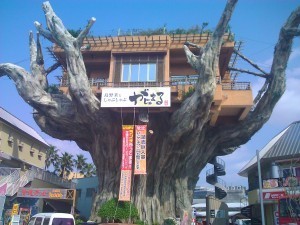Rolf Potts's Blog, page 95
May 13, 2012
You’ll be a happier traveler if you don’t idealize the places you visit
Vagablogging :: Rolf Potts Vagabonding Blog
“Professor James Petrick of Texas A&M, who focuses on psychology and marketing and their application to tourism, has studied when tourists return to destinations or hotels they’ve visited before. Like many in the field, he believes meeting expectations is a key factor. The take-away for travelers: don’t idealize the places you’re visiting and you’ll be much happier in the end. In an interview, Professor Petrick said that one way we can do that is to distinguish between “organic” and “induced” images of a place. In other words, if travelers can discern what a beach destination or a hotel room really looks like (rather than being suckered by a misleading ad campaign or Web site), they will be much happier in the end — a call for us to look carefully for honest photos and unbiased information.”
–Seth Kugel, “Travel Lessons From the World of Academia,” New York Times, Dec. 12, 2011
Original article can be found here: You’ll be a happier traveler if you don’t idealize the places you visit
May 12, 2012
Vagabonding Field Reports: Moving to South Dakota. Wait.. Where?
Vagablogging :: Rolf Potts Vagabonding Blog
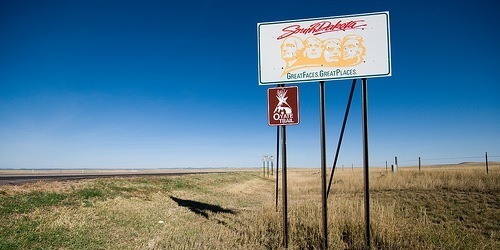
(Border, SD)
“Wait – you’re moving where?”
CP: “South Dakota”
“Why would you ever move there?”
CP: “Well…”
Cost/day: ~$30/day (food / gas / fun)
What’s the strangest thing you’ve seen lately?
When I turned off the Interstate and into Rapid City, I saw (and promptly ignored) a speed limit sign stating 25 mph. Seconds later, I was braking to avoid rear-ending a Chevy truck. Just as I was about to move into the other lane, I noticed that everyone was driving 20mph. Everyone! And there were no police cars present! That’s when I knew this would be different…
Describe a typical day:
I get up, fix myself some eggs and an espresso, then sit on the small deck to enjoy the view.
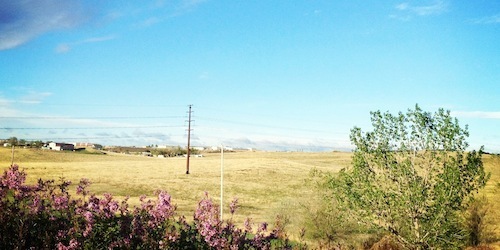
(Rapid City, SD)
Afterward, I make a rough plan of attack for the day and (try to) get the most important thing done. Then I tackle the kettlebells for a bit and have some lunch. After that I get out and go exploring. There are so many things that I don’t yet know about Rapid City, that this may involve finding a new place to buy fresh vegetables and butchered meat — or instead, I may head up into the Black Hills for hiking and take the dirt bike out for a trail ride. (BTW – the Black Hills are absolutely breathtaking.)
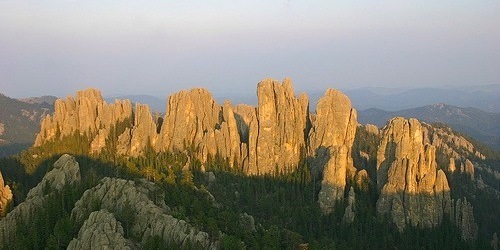
(Needles in the Black Hills, SD)
When I get back – I tackle all of the work I need to get done, which usually involves being locked in front of a laptop for several hours. Afterward, I head out to grab dinner and try to strike up a conversation to two. When I get home, I lock myself in the shop and work on one of my projects — currently building a Jeepspeed desert racer, since I have delusions of tackling the Baja 1000.
Sometime late, I come back in and try to get a little writing done. Eventually I crash and do it all over again.
It’s not the most exciting life, but it is how I recharge. I’m finding that South Dakota is that little oasis of serenity which helps me prepare for each new trip or business venture.
Describe an interesting conversation you had with a local:
I’ve had a few conversations, but the one thing that sticks out is the speed at which everyone talks. Admittedly, I normally talk at a fast clip. When I get excited, I can ramble on faster than a Chihuahua on Red Bull. Now, I find myself intentionally slowing down and often omitting full sections of a story, simply because it will take too long to share. Less is more.
What do you like about where you are? Dislike?
When I lay down at night, I absolutely love the silence. You know that total silence where your ears ring a bit? Something about that allows me to simply let go and completely fade out for a few hours.
While I enjoy the tranquility and slower pace of life, I also want access to cities. Rapid City is only a few miles away and has some great amenities – a good theatre, great restaurants and a fantastic watering hole (the Firehouse Brewing Company).
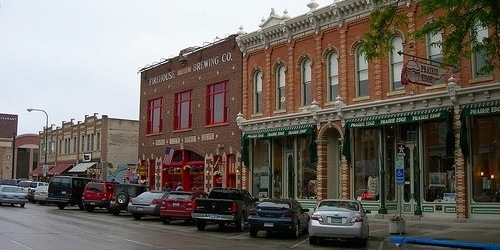
(Rapid City, SD)
Plus there are a few surprises to be found while exploring the town.
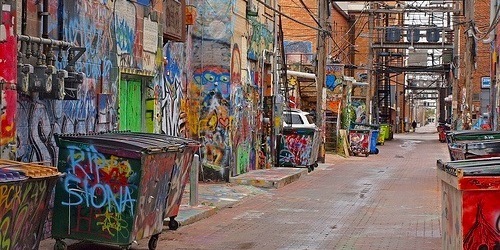
(Graffiti Alley in Rapid City, SD)
I’m 2 miles away from an Interstate and only 15 minutes away from the airport. The only minor dislike is that flights into and out of RAP are more expensive and I need to route through Denver or Chicago. All-in-all, a small price in light of all of the benefits.
Describe a challenge you faced:
Internet connectivity. I just recently moved to a 25mbit connection (upstream and downstream) before I left Philadelphia. While Rapid City has great fiber connectivity (the best in the region) – I’m a few miles outside of town, so I have… nothing. Well – not exactly nothing, but my choices are limited to satellite providers, so we’re talking 2mbit down / 300kbit up and a 450mb limit. Four hundred and fifty megabytes per month? I can blow through that in minutes! Luckily the Verizon LTE coverage in Rapid City is amazing (better than Philadelphia) and I’m able to use it to keep up with my business.
In the end, it forces me to be more particular about what I do online and encourages me to get out into the real world. Once I acclimate, I’m sure I will be better off.
What new lesson did you learn?
At this point in my life, I needed to return to my roots. I was born in Montana and spent 6 year in New Mexico. I simply miss the West and this is the right place for me right now — allowing me to recharge while being the perfect base-of-operations for some incredibly cool adventures that are coming up.
Where next?
For the next month or two, I’m simply settling in and exploring South Dakota. I am, however, planning one of the longest trips I’ve ever taken – which will carry me through Asia and Australia later this year (fingers crossed). More on that later – until then, I’m going to soak up this slower-paced lifestyle.
Original article can be found here: Vagabonding Field Reports: Moving to South Dakota. Wait.. Where?
May 11, 2012
Vagabonding field reports: Once Upon a Time in Okinawa
Vagablogging :: Rolf Potts Vagabonding Blog

Bento lunch boxes at a supermarket
Once upon a time in Okinawa people were so healthy and happy that many of them lived more than one hundred years. The legend says it was because of their special diet, the very active lifestyle (Okinawa is the motherland of Karate) and the strong sense of community that keep everyone together. Still today Okinawa enjoys not only the highest life expectancy but the world’s longest health expectancy. I came here to find out why.
Cost/day
3000 yen (37$) Sleeping was 1000 yen a night, eating little less than 1000 yen, extras 1000 yen.
What’s the strangest thing you’ve seen lately?
Lunch pack culture. Perhaps you have heard about Bento Box, but if you have never been in Japan you may not expect that in any Supermarket or the many Convenience stores that pops out everywhere, you can find such a great selection of just “cooked and packed” food. As much as I like cooking, there is little point in prepare your meal when you have so many yummy options available.
It is also cheaper in most cases to buy a pre cooked meal than cooking, especially in late hours, when the price is heavily discounted because otherwise the day after it will be just thrown away. And remember: the safety standards are probably the highest in the world.
Describe a typical day:
I spent more than two weeks exploring Naha and surroundings, with particular attention to markets and neighborhoods where I could find a traditional living. Unfortunately the island has changed so much in the last years, that new generations of Okinawan are struggling to keep the healthy habits of their ancestors. Except for North of the island (which I have not been yet) everything is now overbuilt like the rest of Japan. And with the addition big of american military bases, Okinawa youngster “enjoy” plenty of american fast foods.
It is said Naha has a great nightlife, but after dark I’ve always been quiet in my guesthouse, working on the computer and chatting with other guests.
TreeHouse Restaurant in Naha, Okinawa
Describe an interesting conversation you had with a local:
The hostel where I stayed was packed with longterm Japan residents. I had impression that they all escaped from mainland Japan and a society too demanding, but in my eyes they looked or gassed out or unable to slow down. In fact, some of them were just vegetating, leaving their dorm cubicle just for eating and smoking or watching tv.
Others, like the volunteers staff, where keep working huge hours. There was a guy who was working 5 night shifts a week in a convenience store, or Mittsu, that not only had to give 24 hours a week in the guesthouse to get a free dorm, she was working 3 hours a day in a café to pay nothing more than her meals and little extras.. So, I asked, did you came to Okinawa to relax? Yes..what am I doing? She wondered perplexed to herself before looking at me.
What do you like about where you are? Dislike?
I liked that after all Okinawa retains a relaxed vibe. The place has still a feeling of unicity, a mix of cultures you wont’ find everywhere.
I disliked that while for the moment the Japanization and Americanization of Okinawa gave to this place more diversity, the changing is happening too fast and I wonder how much of Okinawan fantastic culture can survive.

Can this little kid become another Okinawa Centenarian?
Describe a challenge you faced:
One day in my guesthouse I met Jup Brown, a New Zealander who is living on and off Japan for 18 years. He told me the next day he was going to start S-Miling. In other words he was up to running the whole country for charity: 4200km in 90 days, and he wanted some company. So I decided to join him for two consecutive days. I run (33+40) 73 km. Ok, lots of walking too, but still, it’s almost the distance of a Marathon and with no preparation. It was a great, fun experience and less painful than expected.
What new lesson did you learn?
A lesson I need to learn again and again: manage your expectations. Okinawa turned out to be a different place from the mental image I had formed before come here. I arrived to experience the lifestyle of his many centenarians, but even more than the language barrier, the main obstacle was the big changes occurred in the last years. I don’t think it’s possible not having expectations at all, but we need to be ready to put them apart, especially when you are on the road and want to experience a new culture.
Where next?
After more than 3 weeks in Japan I still feel not able to tune in with the country. My main obstacles so far have been the language barrier and my expectations. So I need to find a quiet place where study Japanese, relax and experience the countryside. When I realized the 80km bus ride to the North of Okinawa, where I couldn’t find any cheap accommodation, cost me almost the same money of the 300km flight to the island of Miyako in the South, famous for the best beaches in the country, my choice was easily made.
Original article can be found here: Vagabonding field reports: Once Upon a Time in Okinawa
Grants for Adventure Travel
Vagablogging :: Rolf Potts Vagabonding Blog
Want a cool $10,000 to fund your craziest travel idea? Outside is seeking proposals for its first-ever adventure travel grant. From the website:
Examples of the kinds of audacious missions we’re looking for—taken from Outside stories—include sailing a homemade raft down the Hudson River, walking a perfectly straight line across Canada’s Prince Edward Island, and paddling a canoe from Portland, Oregon, to Portland, Maine. Fill out the submission form below by May 18.
Looking for other places to fund your adventure travel ideas? The Timmissartok Foundation offers small grants “to assist individuals with adventurous projects that will take place in a foreign country” and is now accepting applications for 2012. You can also check out the Explorers Club, which provides a variety of grants in support of exploration and scientific research to both members and non-members. And, of course, there is National Geographic, which offers highly coveted (and highly competitive) grants through its Expeditions Council.
Finally, if you’re looking for a bit of inspiration, this week the National Geographic Adventure Blog compiled a list of “dream trips” from some of the world’s top athletes. Happy (adventure) travels!
Original article can be found here: Grants for Adventure Travel
May 10, 2012
Journaling on the Road
Vagablogging :: Rolf Potts Vagabonding Blog
Let’s face it, finding time and discipline to write well on the road can be really, really tough. Traveling takes a lot of mental stamina. At the end of a long day, once you’ve found a dinner and settled into the hostel, the last thing you have the mental juice for is thoughtful writing about the day’s events. At that point, your brain doesn’t want to process or reflect. It wants to rest. It’s checked out for the night.
But I try to force myself to journal every night on my travels. I’ve got bags full of bits and pieces from my travels sitting in my closet, but the most important physical souvenirs are the small, leather-bound journals that gather dust on a bookshelf. The journals—weathered and worn—contain the thoughts and impressions of places and experiences recorded in the moment. Some entries are shallow and quickly scribbled; some are well-thought out and insightful.
Most travelers will tell you the same thing; their journals are frayed little time capsules of emotions and experiences they wouldn’t part with for the world. Sometimes they’re written on a rickety milk run train in the countryside, sometimes they’re written while perched on a rock high in the Alps while cowbells jangle in the distance. Sometimes the entries are well-crafted insights inspired while sitting in a soaring cathedral during evensong; other times they’re scribbled late at night while the eyelids are forcing themselves closed and the synapses are shot.
It takes discipline to keep up a journal on the road, but it’s well worth it. We’ll return to the smudged pages at some point in the future and be reminded of a vivid memory, surprising impression, or fleeting thought. And we’ll be glad we had the discipline to stop and record it, even when the train ride was bumpy and the eye lids were heavy.
Pick up that pen, open the book and record a memory to cherish.
Original article can be found here: Journaling on the Road
Want to travel? Wait until you are old
Vagablogging :: Rolf Potts Vagabonding Blog
As I was sitting in Patan’s Durbar Square a few weeks ago, I noticed a couple elder tourists escorted by a guide: they were taking pictures, bending into unnatural shapes. The DSLR cameras they were shooting with looked like some sort of futuristic gear they could barely handle. They seemed quite clumsy and out of place, as they had been cut out from a lifestyle magazine and pasted into another wrong centerfold.
Instantly, I was reminded of the persistent, conservative way of thinking I was pushed to accept back home: before you may travel and enjoy your life, you will have to work a day job and bend your spine behind a desk for 30 years. Kow-tow to the Gods of corporate business. Enjoy the rat race. Then, maybe, you will be able to travel and see the world on a pension.
With a smack of teenage angst, I would promptly reply: “Cool. See the world, on a wheelchair?”
Seeing those tourists made me think that the way I travel in Asia now may not be replicable in about 30 years. Who would be able to take that umpteenth bone melting night bus ride after hitting the 50 years old line? Who would be able to enjoy the tastes and smells of an Indian public bus crammed to the roof with humans and sometimes cattle? And ultimately, who would have the strength to travel slow, soak into a culture or trying to fit into the holes left by mass tourism?
Certainly, not the average Old Joe. Let’s face it: the older you get, the lesser you would be likely to travel hard, especially when you have not been used to it as a young man. And furthermore, when the kind of world we live in constantly conceives travelling as a recreational activity that cannot be taken as a lifestyle, or not even as a part-time occupation.
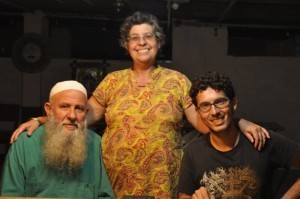
Me with two "Incredible Old Joes": Ibrahim and Saida from Spain. (Picture by Kit Yeng Chan 2012)
Nevertheless, it is quite a contrast – and a funny one – to observe the travelling habits of many older people, some at their very first foray oversea. It appears that so many years spent leading organized, normal lives have not been able to gift these people with a natural inclination to feel relaxed in foreign places. It seems like their movements are harder, slower, filled with the atavist fear of the unknown. They attempt to do what they may have dreamed for many years, but they are doing it with a total regret of having left their comfort zones.
But let me say that I have also met some “Incredible Old Joes”: some were biking from Europe to South East Asia, or doing the same route by walking. Some decided to avoid taking any bus ride longer than 2 hours, to stress less, and see more of the countries they visited. All of them, however, had a common feature: they had been travelling a lot in their younger days. You could clearly see how travelling had enriched their souls… these people may have also been grinding at the office, but oh boy, how freer they were than any of my friends’ –and my own – parents!! I could sit in awe for hours just listening to their life stories.
As much as the mode of travel we use will most likely change or evolve overtime, it appears that to do it with ease we better start young. It surely does not matter how young; but that attitude needs to be embraced early in life, in order not to appear lost in a foreign square taking a bunch of pictures later. In order to actually fit in the broader World, and not be forced to end up lonely on a couch, hypno-entertained by a flat Tv screen.
Have you ever met some experienced older travellers, and do you agree with me? How do they compare to your own older folks at home? I would like to hear some stories.
Original article can be found here: Want to travel? Wait until you are old
May 9, 2012
Return trip expectations
Vagablogging :: Rolf Potts Vagabonding Blog

father time pointing to date 12th January on astronomical clock
On the left, just inside the main door of the Lund Cathedral is a wooden astronomical clock built around 1424. Tangled within a euphoric stare five years earlier, I’d marveled at the intricate details, inhaled the aged wood, and relished the silence which filled the air. The experience rooted such a vivid impression that I’d vowed to return. But expectations were paused as my two friends and I walked in to find the clock being cleaned; all its guts taken apart. Two enormous posters illustrating the clocks face blocked the space where workers placed a table with paint brushes and other tools.

My Dutch friend looking at the astronomical clock
The night before we all went to Lund, I’d expected to perhaps feel the same bliss again in those sandstone walls. Maybe I’d even find the little used book store diagonally across the way with the half-dozen stuffed owls perched on the top shelves. Neither was the same. The clock was in pieces, and the book store gone. But somehow I didn’t feel disappointed, just pensive. And ended up discovering a small tucked away surface where an open book, pen and flickering candle sat. The sign beside said in English (and Swedish), “Do you want to share your prayers with others? Please feel free to write them down in this Book of Intercessions. The book is placed on the altar of the Baptism Chapel during The Service of the Holy communion every Tuesday morning at 08.00 am.” I’m not distinctly religious, but decided to write a prayer in the book.

My written prayer in the Book of Intercessions
My return expectations were very different from the reality of being there the second time. Have you ever felt so moved, even years after, to return to a place? What did you find?
Original article can be found here: Return trip expectations
May 8, 2012
Paying it forward while traveling
Vagablogging :: Rolf Potts Vagabonding Blog
Travel is sometimes considered a selfish act – when we travel, we are constantly taking in the beauty, the culture, the experiences that come from being in a new, different place. We inevitably learn, grow and change as a result.
Along the way, there are people guiding us in some way – and whether it’s by giving directions, translating, offering a room to sleep in, or just by giving a welcoming smile, these encounters are essential to our experience and are often the most significant and memorable parts of the day.
Usually, a smile and a “thank you” is enough to show our appreciation, but in some cases, we might wish there was more we could do. The women behind Spreading Hearts came up with a simple solution on their trip to Africa: They brought several small, pewter hearts and gave them away whenever they felt moved to.
“We would say to an individual something to the effect of, ‘This is for you,’ placing a heart in their hand, and softly acknowledging, ‘You have a beautiful heart, and it touched mine, thank you.’”
I’d heard of Spreading Hearts before I left for my trip a few months ago and thought it was a nice way to spread good while traveling. I was reminded of the concept this week after reading this post, The gift that changes everything on So Many Places blog.
Three weeks before bloggers Kim and Brian leave for their RTW trip, some of their closest friends gave them a gift of money, which came with a letter:
“ … During your travels, we want you to give all of this money away in whatever way you want. You can give it here in the U.S., or in some foreign land. You can be serious in your giving, or be totally crazy, funny or hare-brained. You can give it away visibly or anonymously. You can plan how you are going to do it, or just give it spontaneously in the moment. You can give it to people, to children, to animals or the environment. You can give it all away at once or you can spread it out and give a little bit here, a little bit there. You can give it away in any combination above. We don’t care!
… At the end of the day, the money itself is just paper. What gives the whole experience meaning are the thoughts, emotions and feelings that come along with giving it away in ways that make you smile and make your hearts sing. While doing this bit of creative philanthropy isn’t going to cure cancer or save the rainforest, we hope it can bring a bit of happiness and joy to folks you meet along your adventure- and that it will give you even more fond memories to look back on.”
I think this is a great idea (not to mention a perfect gift for people who are getting rid of all their belongings and don’t need material items). It adds a whole new layer to travel, and it can change our entire outlook on the people we encounter and things we observe every day.
When we travel, we’re stepping on someone else’s turf and accepting the help they naturally want to give us. It only makes sense that we’d give something back – and I like this approach because it’s not only giving, but giving in a way that’s personal, unique and meaningful.
Of course, we can also help in other ways such as volunteering or donating larger sums, but I like the idea of giving on-the-fly, in little ways as well. I don’t think it’s essential – as truly a “thank you” and a smile is often enough – but it does add a new dimension and remind us that traveling is not just about ourselves.
I don’t have any pewter hearts or specific funds set aside for donating to others during my trip, but I do hope to embrace this idea as I go along and will give however I can, whenever the feeling strikes.
What do you think? Do you have a special way of giving back while you travel?
Original article can be found here: Paying it forward while traveling
Gross National Happiness in Bhutan: The price of authenticity in travel
Vagablogging :: Rolf Potts Vagabonding Blog
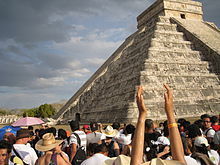
Crowds at Chichen Itza
With a billion people traveling the world each year, travelers must simply search harder to find true authenticity. Natural splendor has been compromised by heavy tourist footprints, and these heavy footprints have steered some of the world’s most beautiful places to the overdeveloped “endangered world heritage sights” list. Spend a day at Machu Picchu or Chichen Itza and you’ll see what I mean.
While the beauty of the world is something that should be shared, some countries are working hard to dissuade the stampeding tourist trail. Most governments have open door tourist policies, encouraging visitors and allowing for independent travel, but what happens when a country says “no” to becoming a victim of its own popularity?
The landlocked kingdom of Bhutan has turned itself into a traveler’s paradise, putting “purpose before profit” with their model of  Gross National Happiness over Gross National Product. Culture seekers (with thick wallets) rejoice, for Bhutan is truly a slice of unspoiled splendor, a place where tourism is woven into local life. Staged experiences are non-existant, and don’t expect to see throngs of bearded, beer guzzling backpackers traveling on a shoestring. The Bhutan tourism board promises that this controlled model will only continue to lure the “high value, low-impact” tourists and avoid a tourism free-for-all. Despite a record 40,000 foreign visitors in 2011, overdevelopment still seems unlikely. Nepal, on the other hand, served 800,000 visitors in 2011 with the help of their “Nepal Tourism Year” campaign. A walk around Kathmandu’s Thamel district will show you what Bhutan is trying to avoid.
Gross National Happiness over Gross National Product. Culture seekers (with thick wallets) rejoice, for Bhutan is truly a slice of unspoiled splendor, a place where tourism is woven into local life. Staged experiences are non-existant, and don’t expect to see throngs of bearded, beer guzzling backpackers traveling on a shoestring. The Bhutan tourism board promises that this controlled model will only continue to lure the “high value, low-impact” tourists and avoid a tourism free-for-all. Despite a record 40,000 foreign visitors in 2011, overdevelopment still seems unlikely. Nepal, on the other hand, served 800,000 visitors in 2011 with the help of their “Nepal Tourism Year” campaign. A walk around Kathmandu’s Thamel district will show you what Bhutan is trying to avoid.
So, what exactly does the country do to set itself apart? A visit to Bhutan comes with a heavy price tag, a price that thrill seeking budget travelers in neighboring countries are unlikely willing to pay. Visitors start by forking over $200 USD per day, a fee which covers accommodation, food, and tour guides. An additional $65 tax is used by the government to fund infrastructure, education, health and other programs. While there is no restriction on tourist numbers, all visits must be arranged through the an official tour operator and the hassle and cost of it all is enough to keep many visitors out of the country. Independent trekkers like those in neighboring Nepal aren’t praised, they’re arrested!
Bhutan may be losing out on tourism dollars, but the “GNH” phenomenon is attracting plenty of foreign attention. Is a trip to authentic Buddhist Bhutan worth the price tag? Do you think open tourism laws ruin any hope of authenticity?
Original article can be found here: Gross National Happiness in Bhutan: The price of authenticity in travel
May 7, 2012
No need to choose between travel and having a family, do both
Vagablogging :: Rolf Potts Vagabonding Blog
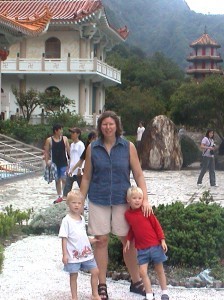 Travel has reached an all-time high on women’s priority lists. According to a poll by Bing, women listed traveling the world as their highest priority. Numbers 2 & 3 were having a family and living in another country respectively.
Travel has reached an all-time high on women’s priority lists. According to a poll by Bing, women listed traveling the world as their highest priority. Numbers 2 & 3 were having a family and living in another country respectively.
I propose that we don’t have to choose. Live in another country with your family and travel when you have a vacation!
OK, OK, that may sound very pie-in-the-sky, but it’s more doable than you might think; my husband and I did it for many years. There are job opportunities abroad for many categories of professions (we’re both teachers) and living abroad is a great opportunity for the entire family.
My husband and I first got teaching jobs in an American school in Egypt, then moved on to Ethiopia after a few years, then to Taiwan and finally Malaysia before deciding to move back to the USA. In all, we taught in international schools for twelve years.
During every vacation from work, we traveled either around the country we lived in or to some other, nearby, country. Once we had children, our kids came with us to explore the world.
There are international opportunities in many professions, including teaching, medicine, engineering, technology, and more. Check around and see what kinds of opportunities are out there for you and take advantage of them. Living abroad is a great way to learn about the world!
Nancy Sathre-Vogel is mom to Family on Bikes, a family of four who recently rode their bikes 17,000 miles from Alaska to Argentina. She blogs about lessons learned from their journey at www.familyonbikes.org
Original article can be found here: No need to choose between travel and having a family, do both
Rolf Potts's Blog
- Rolf Potts's profile
- 323 followers


